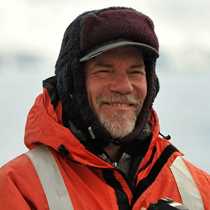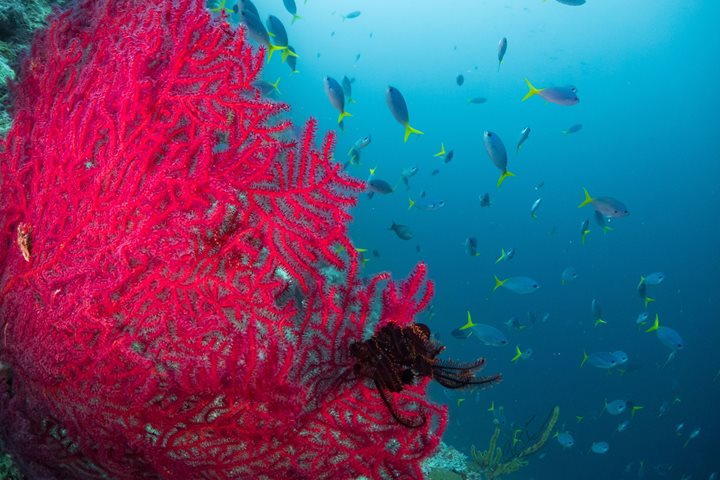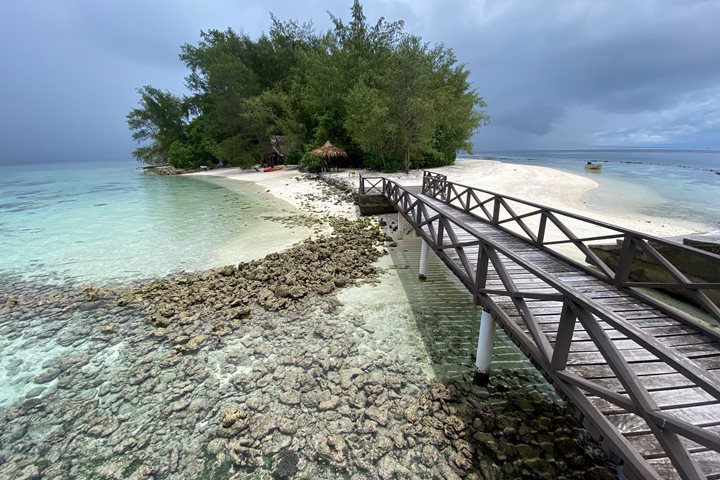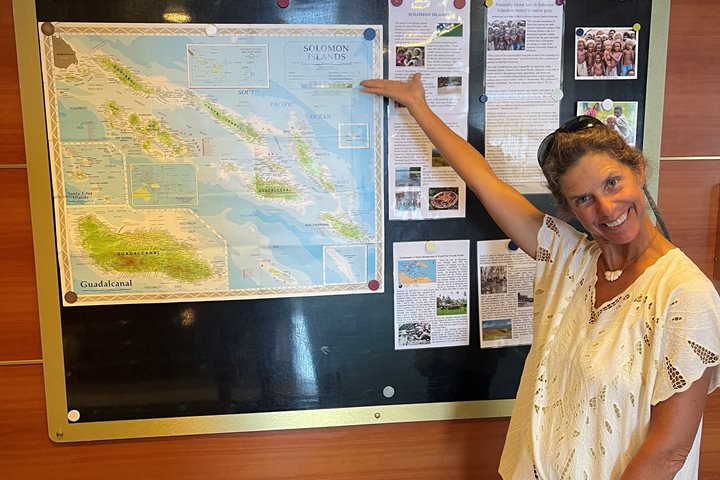Far out into the remote expanse of the Bismarck Sea, north of New Guinea and west of New Britain, we found a hidden treasure: Circular Reef. As National Geographic Orion approached this morning, there was nothing to see above the waves at all. In fact, there were no waves. It was a glassy calm day on this small tropical sea with bright sunshine glinting off the surface, offering perfect conditions for snorkeling. And just under the surface, revealed only by a few low curls of small breakers, we found the spectacular coral walls of Circular Reef. This small atoll is truly a treasure. Uninhabited and very seldomly visited, its walls fall vertically from near the surface to depths of many hundreds of feet and are home to a spectacular variety of reef fish. Swirling over the gorgeous corals were big schools of silver jacks, huge Napoleon wrasses, thousands of brilliantly colored damselfish, small sharks, and much, much more. This remote atoll, concealed beneath the blue waters of the Bismarck Sea, is one of the healthiest reefs I have ever seen, a hidden treasure that we were privileged to visit.
- Daily Expedition Reports
- 20 Oct 2023
Circular Reef, Bismarck Sea, Papua New Guinea, 10/20/2023, National Geographic Orion
- Aboard the National Geographic Orion
- Indonesia & Papua New Guinea
David Cothran, Naturalist/Certified Photo Instructor
David has worked for Lindblad Expeditions-National Geographic since 1993 on six continents and in over 65 countries. David is interested in many of the natural sciences, particularly ornithology, geology and marine biology; he most enjoys contrasting...
Read MoreShare Report
Related Reports
10/25/2023
Read
National Geographic Orion
Solomon Islands
After epic adventures over the top of wild northern New Guinea, National Geographic Orion arrived at the Solomon Islands. After clearing immigration, we went to nearby Kennedy Island where we learned of John F. Kennedy’s heroic swimming efforts after his PT-109 boat sank during World War II. Snorkeling from the beach, the detritus of war covered the sea floor in the form of ship masts and other ship parts. The snorkeling was exceptional and the water super clear. We were immediately greeted by a school of crocodile needlefish and then found some pipefish (a seahorse relative) and the most amazing fish of them all, the crocodile fish. Incredibly well camouflaged by its large, flat, and elongated head, it looks just like a crocodile and its fins look like feet! Wow! In the afternoon, we went ashore on Kolombangara Island for a walk in the rainforest. The volcanic cone of Kolombangara rises from a circular 18-mile base to a crater rim at 5840’. The last eruption was over 10,000 years ago, and the cone has since heavily eroded, with a major gash in one side where the Vila River drains the center of the crater. After hearing some amazing marimba music at the landing, we hopped into the back of trucks and headed up the mountain. Driving through tree plantations, it was obvious the land had a story to tell. The Solomon Islands have been subjected to many outside forces that have contributed to the pillaging of natural resources. In 1905, the British thought the island was largely uninhabited, not realizing that people were living on the higher slopes and in the valleys of the crater. Lever Brothers were given a license to use the land for 999 years to grow coconut palm trees to produce oil for soap. In 1968, the focus shifted to timber. Levers Pacific Timber, a subsidiary of the larger Unilever Company, began extensive logging of the rainforests of the lower slopes. Very few trees were left standing on the coastal lands of Kolombangara. Today, 60% of the lease lands are owned by a Taiwanese investor. The logging activities have destroyed the unique flora and fauna of the lower elevations. In 2008, landowners signed a Conservation Agreement that promised they would not log or mine above 1300’ altitude. This agreement is not without threat, and today, there are efforts to turn the area into a national park. After driving up the mountain, we arrived at Imbu Rano Lodge. The lodge looks out over the Vila River valley and across to the high crater rim summit of the 5570’ Mt Rano, one of the highest peaks of Kolombangara Island. From there, we divided into groups to explore the amazing forests of the crater.
10/24/2023
Read
National Geographic Orion
Day at Sea
Onboard National Geographic Orion , we spent the day at sea as we made our way to the Solomon Islands. The day was full of presentations and galley tours. Undersea Specialist Mike G. did a presentation on reef fish. We spent time spotting wildlife from the bow with much success. We finished the day with the famous National Geographic Orion Crew Show, which was delightful.







